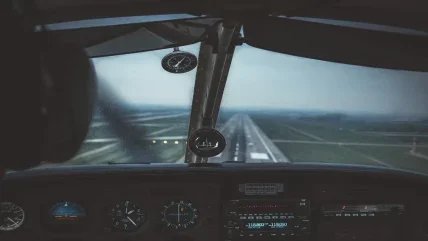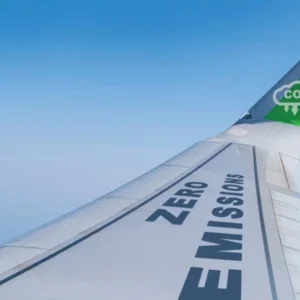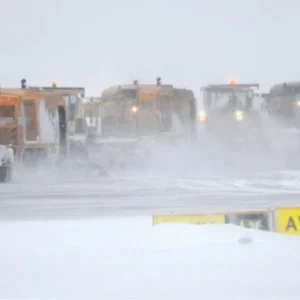
The best-known ghost story within the aviation industry is that of Eastern Air Lines 401 and, as with most ghost stories, it has a tragic beginning. Shortly before midnight on 29 December 1972 – while en route from New York JFK to Miami – the aircraft crashed into the Florida Everglades, killing all three cockpit crew members, two of the ten flight attendants, and 96 of the 163 passengers.
The accident occurred after a burnt-out landing gear indicator light distracted the cabin crew, preventing them from noticing that the autopilot had become disconnected and, as a result, the aircraft gradually lost altitude and crashed. This was the first ever fatal crash of a wide-body aircraft – it was also the first hull loss and first fatal crash of a Lockheed L-1011 TriStar.
Over the following years, rumoured sightings began to circulate of the dead Captain Robert Loft and Second Officer Donald Repo, sitting on board other L-1011s. Parts of the crashed aircraft had been salvaged after the investigation and refitted into other L-1011s. The reported hauntings were said to be seen only on aircraft that used spare parts salvaged from the crashed aircraft.
While Eastern Air Lines publicly denied the veracity of the rumours and ordered staff to refrain from spreading them, the company reportedly removed all the salvaged parts from its L-1011 fleet. And, over time, the reporting of ghost sightings stopped.
In 2022, ‘ghost flights’ have hit the headlines once again, but now they are of a very different nature. In late January, airlines in the UK warned that they would be forced to run flights with less than 10% passenger capacity. This was due to new rules requiring carriers to fly more regularly to retain their lucrative take-off and landing slots at airports, sparking off a fresh debate.
Airlines are allocated specific time slots at busy airports to help ensure that runways are used as efficiently as possible. These landing rights are among an airlines’ most valuable assets and can be worth tens of millions of pounds. For the UK, the threshold for the use of these slots stood at 80% in pre-Covid times, which was about the same throughout Europe – if an airline failed to hit this threshold, it could lose the slot. During the pandemic, the threshold had been put on hold, and then run at a considerably reduced level once air travel resumed.
Pre-Covid-19, these so-called ‘use it or lose it’ rules had been implemented to help keep the industry competitive by incentivising airlines to fly routes, trade them or hand them back so other carriers, including new market entrants, could use them instead.
As governments and governing bodies look to move on from the restrictions and regulations around Covid-19, the fear for airlines, and legacy carriers in particular, is that passenger traffic will not rise at the same rate. If airlines are being required to run more flights, concerns grow over their ability to fill them.
Cause for concern
The issue at the heart of this debate, of course, is that air travel is a very carbon-intensive activity, and the concept of ghost flights has proved to be a flashpoint for those campaigning for action on the climate crisis. Aviation is responsible for around 2.4% of global CO2 emissions, and when you take the other gases and water vapour trails produced by aircraft into account, the industry holds responsibility for around 5% of global warming.
So, in January 2022, after airlines made the announcement regarding their need to run ghost flights, the environmental activist group Greenpeace warned that at least 100,000 ghost flights could be flown across Europe over the winter months from the end of 2021 to early 2022. These flights were estimated to generate up to 2.1 million tonnes of greenhouse gas emissions – or as much as 1.4 million average petrol or diesel cars emit in a year.
The cause for concern stemmed from a UK Department of Transport announcement on plans to compel airlines to hand back airport slots if they were not used 70% of the time from 27 March. This would rise from the then-threshold of 50%.
Backlash to the Department of Transport’s announcement was swift. Many airline representatives were quick to point out that the slot usage threshold proposed would be the highest in the world, and voiced scepticism over whether such measures were useful for both travellers and the air travel industry.
“It is inconceivable that international demand will average 70% this summer. The government is therefore condemning airlines to operate thousands of flights at low capacity, which is environmentally stupid,” said Willie Walsh, director general of the International Air Traffic Association, in a press release at the time.
Low-cost versus legacy airlines
Many low-cost carriers took a different tune, however. Ryanair CEO Michael O’Leary took a shot at Lufthansa in mid-January, after the latter carrier came out against Brussel’s changes to the EU’s ‘use it or lose it’ rules. Here, the European Commission was looking to raise the threshold from 50% to 64% by the end of March – also down from a pre-pandemic requirement of 80%.
Lufthansa CEO Carsten Spoher argued instead for softer thresholds for airlines, claiming that the 50% level was already forcing the carrier to put on 18,000 “unnecessary” flights in January and February alone. Prior to the EU’s announcement on the change to threshold levels, Lufthansa had been looking to cancel 33,000 flights that it would have run in a normal year.
O’Leary was scathing, noting that legacy carriers like Lufthansa already benefitted greatly from the EU’s Covid measures due to pandemic bailouts and softer slot rules. “And now Lufthansa’s still not happy. They don’t want to operate ghost flights because: ‘Ohhh, the environment’,” he said in an interview with Politico, going on to refer to Lufthansa’s concerns over emissions as “crocodile tears”.
“If Lufthansa doesn’t want to operate ‘ghost flights’ to protect its slots, then simply sell these seats at low fares, and help accelerate the recovery of short and long-haul air travel to and from Europe,” he added.
Of course, it is not as if O’Leary is an unbiased observer in all of this. Low-cost carriers like Ryanair had been looking to expand as the global recovery from the pandemic continues and scooping up the landing and take-off slots that network airlines – whose long-haul routes have been slower to recover – would be one way to do so. Indeed, Ryanair would go on to fly more passengers in May 2022 than it had in May 2019 – a truly remarkable post-Covid recovery.
Lufthansa, in turn, argued that customers were not being kept away by a reluctance to provide cheaper fares but by pandemic travel restrictions. The truth of the matter, as is so often the case, probably fell somewhere in the middle.
The Ryanair CEO was not the only one to come out against Lufthansa, however. EU Transport Commissioner Adina Valean also took aim at Lufthansa, pointing out that data from traffic manager Eurocontrol showed that, in early January, the airline operated more than 60% of flights compared with the same period in 2019. That was more than the existing rules required at the time for carriers to keep hold of a slot.
“It is difficult to see why Lufthansa would need to operate the claimed 18,000 flights, accounting for only 5% of its total flights in the winter scheduling season, to protect their slots portfolio,” she wrote to the European Parliament’s transport committee chair Karima Delli – who had called for changes to the rules in response to Lufthansa’s demands – in a letter obtained by Politico.
Revenants without reason
Yet, even when the threshold rules have been suspended entirely, ghost flights have still been carried out by airlines. Data released by the UK Department for Transport in February showed that some 14,472 ghost flights took place between March 2020 and September 2021 at the height of the pandemic – even though carriers did not have to operate flights to retain slots.
“Flights may operate with a low number of passengers for a range of reasons,” said Aviation Minister Robert Courts, who produced the data in response to a parliamentary question. “Since the onset of the pandemic, the government has provided alleviation from the normal slot regulations. This means that airlines have not been required to operate empty or almost empty flights solely to retain their historic slots rights.”
These 14,472 ghost flights operated from all 32 airports named in the released data. Heathrow was top, with 4,910 ghost flights between the March 2020 and September 2021 period, followed by Manchester and Gatwick airports. This comes to an average of 760 ghost flights a month over the time frame in question, although the data covered only international departures and not domestic flights, so the true number could be higher still.
Of course, there was more to come. In late March 2022, data obtained by the Guardian via a freedom of information request to the Civil Aviation Authority (CAA) – the UK’s aviation regulator – revealed that almost 500 ghost flights a month departed between October and December 2021. Again, this data only included flights that departed from the UK, omitting arrivals and domestic travel. The airports that saw the most ghost flights in this period were Heathrow, Aberdeen, Manchester, Stansted and Norwich.
It is worth noting that airport representatives have not held back from voicing their side of this debate either. In November 2021, Gatwick, Belfast and Edinburgh formed a coalition with low-cost carrier Wizz Air to argue for the reinstatement of the normal 80% slot rule threshold in a letter to the UK government. As air travel began to recover, Gatwick was suffering from the absence of British Airways and Virgin Atlantic, both of which had decided to focus their operations out of Heathrow, yet were allowed to keep their Gatwick slots.
“The slot rules help maximise competition by keeping airfares low while increasing their choice of destinations and airline,” Gatwick airport’s chief commercial officer, Jonathan Pollard, told the Independent at the time. “Restoring the slot rules would be a clear signal that the UK government is getting fully behind the recovery of the UK aviation sector.”
Here comes the summer
As airports and airlines enter the summer, one of the leading stories has been the industry’s struggle to keep up with the exploding demand, with much of the world looking to catch up on travel now that the worst effects of the pandemic have passed. Flight cancellations, labour shortages and unprecedented levels of crowding in terminals all signal a demand for travel that should give comfort to those parts of the industry still waiting to feel the effects of the recovery.
While certainly posing serious problems in the short term, the industry is hard at work to overcome these temporary obstacles. And if passenger traffic continues to rise, then the need for ghost flights falls in tandem to it. As long as travellers remain patient and traffic levels hold strong throughout the summer – alongside the ongoing rollback of Covid regulations – this summer should provide the exorcism needed to banish the ghosts from our skies for good.
14,472
The number of ghost flights that took place in the UK between March 2020 and September 2021.
UK Department of Transport
500
The number of ghost flights that left the UK each month between October and December 2021.
Civil Aviation Authority






